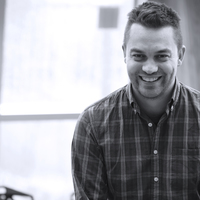
Teddie Potter
Supervisors: Carey Clark RN, PhD., Riane Eisler JD, and Mary Johnson RN, PhD.
less
Related Authors
Richard Gray
La Trobe University
Sayonara Barbosa
University of Cincinnati
Ana Porroche Escudero
Lancaster University
Adam Gaudry
University of Alberta
Alejandra B Osorio
Wellesley College
Antonella Riem Natale
Università degli Studi di Udine / University of Udine
David Seamon
Kansas State University
Armando Marques-Guedes
UNL - New University of Lisbon
Florin Curta
University of Florida
John Sutton
Macquarie University
InterestsView All (17)










Uploads
Papers by Teddie Potter
followers, the idea quickly becomes marginalized. It “takes a village” to build a movement, and the
more system layers that can be addressed, the more likely the transformation will take hold. This
article describes the framework for creating the necessary changes for partnership-based health care.
It also makes suggestions for ensuring successful application of partnership-based systems change. This
article is for all readers seeking to apply partnership principles in their own fields of influence.
Carey Clark RN Ph.D., Committee Chair
California Institute of Integral Studies, 2010
RECONSTRUCTING A NEW STORY OF NURSING:
CRITICAL ANALYSIS OF NURSING TEXTBOOKS USING
RIANE EISLER’S PARTNERSHIP PARADIGM
ABSTRACT
Paradigms and stories shape our perception of the world around us; they frame the past and suggest possible futures. Nursing fundamental textbooks initiate socialization for and profoundly impact the self-identity and practice of future nurses; therefore, the paradigms and ideologies within the texts must be critically evaluated. Chapters describing the history of nursing offer powerful stories and images that initiate the development of nursing identity in novices.
Social theorist Riane Eisler (1987, 2002) describes human history as a persistent conflict between two paradigms or patterns of social organization. Her cultural transformation theory identifies ideological differences between dominator and partnership paradigms.
The first objective of the present study was to determine if nursing fundamental textbooks in the United States use the story of the history of nursing to support a dominator paradigm. The history of nursing was critiqued in eight current nursing fundamental textbooks. Content and narrative analysis revealed that dominator values and themes were consistently used while partnership themes were weak or absent.
The second objective of the study was to reconstruct a new story of nursing by illuminating historic exemplars of partnership and collaboration. Recent nursing research has demonstrated patient outcomes improve with implementation of collaborative care, yet new nurses have limited exposure to models of collaboration.
The writings of Mary Seacole (1857/2005), Lillian Wald (1915), Margaret Sanger (1923/1971), Sister Elizabeth Kenny (Kenny & Ostenso, 1943), and others were analyzed for themes that support partnership and collaboration. Content analysis also revealed themes of the interconnection of humans and nature, the importance of a global perspective, the use of multiple ways of knowing, the value of astute observation, and the necessity for medicine to be individualized. Recovering lost threads of the nursing story will improve self-identity and empower nurses to be active partners in the creation and delivery of sustainable models of healthcare.
ILLUMINATING PATTERNS OF PARTNERSHIP
Aim of study
Social theorist Riane Eisler describes human history as a persistent conflict between two patterns of social organization. Her Cultural Transformation Theory identifies ideological differences between dominator and partnership paradigms. The first objective of this study was to determine if nursing fundamental textbooks in the United States use the story of the history of nursing to support a dominator paradigm. The second objective was to illuminate historic exemplars of partnership in nursing.
Rationale/significance
Nursing fundamental textbooks initiate socialization and profoundly impact the self-identity and practice of future nurses. Therefore the assumptions and ideologies within the texts must be critically evaluated. Assumptions and beliefs are most evident in chapters describing the history of nursing. These sections offer powerful images that initiate development of nursing identity in novices. Recent nursing research has demonstrated patient outcomes improve with implementation of collaborative care. Yet new nurses are exposed to limited models of collaboration. To shift the current health care paradigm, nurses need to be educated in partnership. History provides inspirational stories of nurses who partnered with patients to create new models of care.
Methodology
This study applies a Critical Theory approach to reveal and deconstruct current ideological messages embedded in the history of nursing chapters in nursing fundamental textbooks. The writings of Mary Seacole, Lillian Wald, Sister Elizabeth Kenny, and Mamie Odessa Hale are analyzed for themes that support an alternative paradigm of partnership and collaboration.
Findings
Nursing has a rich history of collaboration and partnership but currently dominator stories are used more frequently to socialize novices. The writings of nurses through history provide inspiring examples of partnership care. Despite dominator pressures, nursing pioneers offered alternative models of care based on respect and empowerment.
Conclusions
The history of nursing in nursing textbooks is essentially a subjective story carefully crafted to impart select values to new nurses. Currently nursing is defined by the needs of health care systems. Loss of identity promotes powerlessness and decreases meaning and career satisfaction for nurses. This contributes to attrition and the critical shortage of nurses. Eisler’s theory offers insights about the historic roots of the dominator paradigm which limits the art of caring today. This research demonstrates collaboration and partnership have been part of the nursing identity through history. Recovery of this lost thread of history may improve patient care outcomes and enrich nursing practice.
solved with a massive influx of capital nor will they be erased with restructuring. Any
solution will prove temporary unless our story about health and healing shifts. The
biomedical story is fraught with dualisms. These include but are not limited to mind-
body, patient-caregiver, and nature-human dichotomies. Each of these dualities
profoundly impact and limit human healing potentials. OBJECTIVE: To break free of
this paradigm, the current history of nursing is deconstructed. My research explores the
way this story socializes new nurses into dualistic ways of thinking/being. The current
story’s assumptions and limitations are illuminated and the deleterious impact on patient
care and nursing is discussed.
METHOD: This transdisciplinary study deconstructs the
history of nursing in current fundamental textbooks. The assumptions and ideologies
embedded in these texts provide the earliest socialization to the role of the nurse therefore
critique is imperative. A new story of nursing is then constructed based on themes from
historical narratives of healers. Nursing did not begin with Florence Nightingale in 1850.
It originated with the earliest indigenous healers. Indigenous healers teach that health is
intimately bound to community, environment, and nondualistic ways of knowing/being.
RESULTS: The new story of nursing emphasizes cultural, cognitive, and environmental
relationships based on partnership. These three foci hold tremendous potential for shifting
our response to health and health care.
CONCLUSION: Provider education strongly influences whether there will be a paradigm shift in health care. Nondualistic theory and practice need to be incorporated into provider curriculum in order for health care to be
transformed.
Talks by Teddie Potter
followers, the idea quickly becomes marginalized. It “takes a village” to build a movement, and the
more system layers that can be addressed, the more likely the transformation will take hold. This
article describes the framework for creating the necessary changes for partnership-based health care.
It also makes suggestions for ensuring successful application of partnership-based systems change. This
article is for all readers seeking to apply partnership principles in their own fields of influence.
Carey Clark RN Ph.D., Committee Chair
California Institute of Integral Studies, 2010
RECONSTRUCTING A NEW STORY OF NURSING:
CRITICAL ANALYSIS OF NURSING TEXTBOOKS USING
RIANE EISLER’S PARTNERSHIP PARADIGM
ABSTRACT
Paradigms and stories shape our perception of the world around us; they frame the past and suggest possible futures. Nursing fundamental textbooks initiate socialization for and profoundly impact the self-identity and practice of future nurses; therefore, the paradigms and ideologies within the texts must be critically evaluated. Chapters describing the history of nursing offer powerful stories and images that initiate the development of nursing identity in novices.
Social theorist Riane Eisler (1987, 2002) describes human history as a persistent conflict between two paradigms or patterns of social organization. Her cultural transformation theory identifies ideological differences between dominator and partnership paradigms.
The first objective of the present study was to determine if nursing fundamental textbooks in the United States use the story of the history of nursing to support a dominator paradigm. The history of nursing was critiqued in eight current nursing fundamental textbooks. Content and narrative analysis revealed that dominator values and themes were consistently used while partnership themes were weak or absent.
The second objective of the study was to reconstruct a new story of nursing by illuminating historic exemplars of partnership and collaboration. Recent nursing research has demonstrated patient outcomes improve with implementation of collaborative care, yet new nurses have limited exposure to models of collaboration.
The writings of Mary Seacole (1857/2005), Lillian Wald (1915), Margaret Sanger (1923/1971), Sister Elizabeth Kenny (Kenny & Ostenso, 1943), and others were analyzed for themes that support partnership and collaboration. Content analysis also revealed themes of the interconnection of humans and nature, the importance of a global perspective, the use of multiple ways of knowing, the value of astute observation, and the necessity for medicine to be individualized. Recovering lost threads of the nursing story will improve self-identity and empower nurses to be active partners in the creation and delivery of sustainable models of healthcare.
ILLUMINATING PATTERNS OF PARTNERSHIP
Aim of study
Social theorist Riane Eisler describes human history as a persistent conflict between two patterns of social organization. Her Cultural Transformation Theory identifies ideological differences between dominator and partnership paradigms. The first objective of this study was to determine if nursing fundamental textbooks in the United States use the story of the history of nursing to support a dominator paradigm. The second objective was to illuminate historic exemplars of partnership in nursing.
Rationale/significance
Nursing fundamental textbooks initiate socialization and profoundly impact the self-identity and practice of future nurses. Therefore the assumptions and ideologies within the texts must be critically evaluated. Assumptions and beliefs are most evident in chapters describing the history of nursing. These sections offer powerful images that initiate development of nursing identity in novices. Recent nursing research has demonstrated patient outcomes improve with implementation of collaborative care. Yet new nurses are exposed to limited models of collaboration. To shift the current health care paradigm, nurses need to be educated in partnership. History provides inspirational stories of nurses who partnered with patients to create new models of care.
Methodology
This study applies a Critical Theory approach to reveal and deconstruct current ideological messages embedded in the history of nursing chapters in nursing fundamental textbooks. The writings of Mary Seacole, Lillian Wald, Sister Elizabeth Kenny, and Mamie Odessa Hale are analyzed for themes that support an alternative paradigm of partnership and collaboration.
Findings
Nursing has a rich history of collaboration and partnership but currently dominator stories are used more frequently to socialize novices. The writings of nurses through history provide inspiring examples of partnership care. Despite dominator pressures, nursing pioneers offered alternative models of care based on respect and empowerment.
Conclusions
The history of nursing in nursing textbooks is essentially a subjective story carefully crafted to impart select values to new nurses. Currently nursing is defined by the needs of health care systems. Loss of identity promotes powerlessness and decreases meaning and career satisfaction for nurses. This contributes to attrition and the critical shortage of nurses. Eisler’s theory offers insights about the historic roots of the dominator paradigm which limits the art of caring today. This research demonstrates collaboration and partnership have been part of the nursing identity through history. Recovery of this lost thread of history may improve patient care outcomes and enrich nursing practice.
solved with a massive influx of capital nor will they be erased with restructuring. Any
solution will prove temporary unless our story about health and healing shifts. The
biomedical story is fraught with dualisms. These include but are not limited to mind-
body, patient-caregiver, and nature-human dichotomies. Each of these dualities
profoundly impact and limit human healing potentials. OBJECTIVE: To break free of
this paradigm, the current history of nursing is deconstructed. My research explores the
way this story socializes new nurses into dualistic ways of thinking/being. The current
story’s assumptions and limitations are illuminated and the deleterious impact on patient
care and nursing is discussed.
METHOD: This transdisciplinary study deconstructs the
history of nursing in current fundamental textbooks. The assumptions and ideologies
embedded in these texts provide the earliest socialization to the role of the nurse therefore
critique is imperative. A new story of nursing is then constructed based on themes from
historical narratives of healers. Nursing did not begin with Florence Nightingale in 1850.
It originated with the earliest indigenous healers. Indigenous healers teach that health is
intimately bound to community, environment, and nondualistic ways of knowing/being.
RESULTS: The new story of nursing emphasizes cultural, cognitive, and environmental
relationships based on partnership. These three foci hold tremendous potential for shifting
our response to health and health care.
CONCLUSION: Provider education strongly influences whether there will be a paradigm shift in health care. Nondualistic theory and practice need to be incorporated into provider curriculum in order for health care to be
transformed.
Minneapolis Community and Technical College is the most ethnically diverse nursing program in the state of Minnesota. About 30% of our nursing students are students from non-native English speaking countries. Research showed approximately 47% of non-native English speaking students failed at least one nursing course compared to 16% of native English speaking students. I completed a year long sabbatical project to determine the reasons for these disparate results.
Based on my findings I have developed a partnership approach to test taking instruction. This presentation will present test analysis data and discuss the NCLEX questions most likely to be problematic. It will then discuss a rubric for guiding the student towards improved scores.
CHALLENGING THE EMBEDDED IDEOLOGY
Aim of study
The purpose is to identify ideological messages in nursing fundamental textbooks, which confuse nursing identity and diminish the healing potential of nurses.
Rationale/significance
Nursing fundamental textbooks initiate socialization and profoundly impact the self-identity and practice of future nurses. Therefore assumptions and ideologies within the texts must be critically evaluated. Assumptions and beliefs are most evident in chapters describing the history of nursing. They transmit powerful images that initiate development of nursing identity. With a more inclusive history of nursing students can make fully informed decisions about a broader range of options in nursing care.
Methodology
Chapters containing the history of nursing, in the most current edition of seven nursing fundamentals textbooks were evaluated using content and narrative analysis. Two editions of the same text were compared for changes over time.
Findings
Each textbook acknowledged the importance of nursing history while dedicating less than one percent of total content to historical material. Sixty percent of the texts cited “the future is a product of the past” as the primary reason for studying nursing history. Only forty percent suggested history could be used to inspire and guide nurses. There was lack of consensus regarding definitions of nursing and professionalism and the meaning of service. These texts generally ignored the profound historical contributions of nurses throughout the world. Each text differed in the historical content used to create an image of nursing. Seventy percent of the texts cited the mother/child relationship as the template for nursing. There is limited coverage of herbalists, midwives, and other autonomous models of nursing. Data also indicates ambivalence about the connection of nursing and spirituality. Several texts made assertions about nursing care in the past but these claims were not based on research. Application of historical research was very limited with an average use of four references per text.
Conclusions
The history of nursing in nursing textbooks is essentially a subjective story carefully crafted to impart select values to new nurses. Nursing is defined by the current needs of health care systems. This decreases meaning and career satisfaction for nurses. A deeper grasp of the history of healing is needed to create grounded nursing identity. If historical data is threaded through fundamental textbooks, future nurses will have a broader understanding of the healing traditions and the healing choices they can make in patient care
Teddie M. Potter, PhD, MS, RN
Abstract
Societal transformation often starts with one visionary and a compelling idea. However, if there are no followers, the idea quickly becomes marginalized. It “takes a village” to build a movement, and the more system layers that can be addressed, the more likely the transformation will take hold. This article describes the framework for creating the necessary changes for partnership-based health care. It also makes suggestions for ensuring successful application of partnership-based systems change. This article is for all readers seeking to apply partnership principles in their own fields of influence.
Keywords
Cultural Transformation Theory; health care; interprofessional; paradigm; partnership
http://z.umn.edu/ijps118
Recommended Citation
Potter, T.M. (2014). Partnership-Based Health Care: Suggestions for Effective Application. Interdisciplinary Journal of Partnership Studies, 1(1), article 8.
Copyright
©2014 Potter. This is an open-access article distributed under the terms of the Creative Commons Noncommercial Attribution license (CC BY-NC 4.0), which allows for unrestricted noncommercial use, distribution, and adaptation, provided that the original author and source are credited.